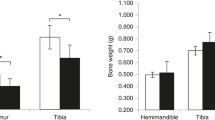Abstract
The goal of this study was to find out if bone can recover after long-term administration of bisphosphonate. Disodium pamidronate (APD) was given orally by gavage to mature beagle dogs at doses of 0, 2.5, 12.5, and 25 mg/kg/day for 1 year (0.1% concentration) and the animals were allowed to recover for another year. At sacrifice, the os ilium was used to determine bone mineralization profile and, subsequently, each density fraction was analyzed chemically. The ribs were used to determine the lattice parameters and the size of the apatite crystals of bone. The sternum was used to determine selected morphometric parameters using image analysis of specimen X-ray films and, subsequently, to determine bone mechanical properties using a 3-point bending technique. We found that the 12.5 and 25 mg/kg/day doses exhibit a significant shift towards greater mineralization versus control, whereas the lower dose (2.5 mg/kg/day) was indistinguishable from the controls. The lattice parameters and crystal size of bone apatite remained unchanged. The image analysis shows a dose-related increase in trabecular volume and thickness. The connectivity increased with dose but the anisotropy of bone remained unchanged. Both the elastic modulus and the maximum stress of bone remain unaffected by APD. We conclude that when dogs are treated with APD for 1 year, their bones can reestablish their physical-chemical characteristics (mineralization profile, chemistry, and crystal size/strain) after 1 year of recovery, provided that the treatment doss is 2.5 mg/kg/day. In addition, the mechanical properties of the bone remained unaffected and the gains in trabecular volume and thickness are maintained.
Similar content being viewed by others
References
Francis MD, Martodam RR (1983) Chemical, biochemical and medicinal properties of the diphosphonates. In: Hildebrand RL (ed) The role of phosphonates in living system. CRC Press, Boca Raton; pp 55–96
Jung A, Bisaz S, Bartholdi P, Fleisch H (1973) Influence of pyrophosphate on the exchange of calcium and phosphate ions on hydroxyapatite. Calcif Tissue Res 13:27–40
Shinoda HR, Adamek G, Felix R, Fleisch H, Schenk R, Hagan P (1983) Structure-activity relationships of various biphosphates. Calcif Tissue Int 35:97–99
Schenk R, Eggli P, Fleisch H, Rosini S (1986) Quantitative morphometric evaluation of the inhibitory activity of new aminobisphosphonates on bone resorption in the rat. Calcif Tissue Int 38:342–349
Papapoulos SE, Landman JO, Bijvoet OLM, Löwik WGM, Valkema R, Pauwels EKJ, Vermeij P (1992) The use of bisphophonates in the treatment of osteoporosis. Bone 13:S41-S49
Frijlink WB, Te Velde J, Bijvoet OLM, Heynen G (1979) Treatment of Paget's disease with (3-amino-1-hydroxypropylidene)-1,1-bisphosphonate (APD). Lancet i:799–803
Canfield RE (ed) (1987) Etidronate disodium: a new therapy for hypercalcemia of malignancy. Am J Med 82:2A:1–8
Fromm GA, Vega E, Plantalech L, Galich AM, Mautalen CA (1991) Differential action of pamidronate on trabecular and cortical bone in women with involutional osteoporosis. Osteoporosis Int 1:129–133
Grynpas MD, Acito A, Dimitriu M, Mertz BP, Very JM (1992) Changes in bone mineralization, architecture and mechanical properties due to long-term (1 year) administration of APD to dogs. Osteoporosis Int 2:74–81
Bonar LC, Rougosse AH, Sabine WK, Grynpas MD, Glimcher MJ (1983) X-ray diffraction studies of the crystallinity of bone mineral in newly synthesized and density fractionated bone. Calcif Tissue Int 35:202–209
Grynpas MD, Patterson-Allen P, Simmons DJ (1986) The changes in quality of mandibular bone mineral in otherwise totally immobilized rhesus monkeys. Calcif Tissue Int 39:57–62
Serra J (1988) Image analysis and mathematical morphology, vol 1, Academic Press, London
Grynpas MD, Hunter GK (1988) Bone mineral and glycosaminoglycans in newborn and mature rabbits. J Bone Miner Res 3:159–164
Ambus T, Korogyi N, DeCampos F, Groom B, Innanen VT (1990) Evaluation of the Beckman Synchron CX4 clinical chemistry analyzer in a hospital laboratory. J Clin Lab Anal 4:120–125
Engleman EE, Jackson LL, Norton DR (1985) Determination of carbonate carbon in geological materials by coulometric titration. Chem Geol 53:125–128
Very JM, Baud CA (1984) X-ray diffraction of calcified tissues. In: Dickson GR (ed) Methods of calcified tissue preparation. Elsevier, Amsterdam, pp 369–387
Jacquet J, Very JM, Flack HD (1980) The 2θ determination of diffraction peaks from ‘poor’ powder samples. Application to biological samples. J Appl Cryst 13:380–384
Chappard D, Petitjean M, Alexandre C, Vico L, Minaire P, Riffat G (1991) Cortical osteoclasts are less sensitive to etidronate than trabecular osteoclasts. J Bone Miner Res 6:673–680
Einhorn T, Peter CP, Clair J, Rodan GA, Thompson DD (1990) Effect of Allendronate on mechanical properties of bone in rats and dogs. J Bone Miner Res 5(96):597
Ferreti JL, Cointry G, Capozza R, Montuori E, Roldan E, Pérez Lloret A (1990) Biomechanical effects of the full range of useful doses of APD on femur diaphyses and cortical bone tissue in rats. Bone Miner 11:111–122
Valkema R, Vismas F-JFE, Papapoulos SE, Pauwels EKJ, Bijvoet OLM (1989) Maintained improvement in calcium balance and bone mineral content in patients with osteoporosis treated with the bisphosphonate APD. Bone Miner 4:S183–192
Author information
Authors and Affiliations
Rights and permissions
About this article
Cite this article
Grynpas, M.D., Kasra, M., Dumitriu, M. et al. Recovery from pamidronate (APD): A two-year study in the dog. Calcif Tissue Int 55, 288–294 (1994). https://doi.org/10.1007/BF00310408
Received:
Accepted:
Issue Date:
DOI: https://doi.org/10.1007/BF00310408




